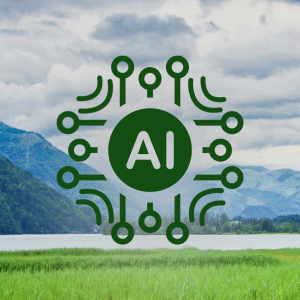Share This
By: Jacob Drouin
With 2023’s artificial intelligence boom, investments and innovation in tech took a hard pivot toward machine learning. Leading into the new year, companies and organizations across all sectors are searching for ways to optimize and reimagine what they do using the technology. Still, with media coverage of AI almost exclusively focused around its growing list of capabilities, it’s easy to forget the back-end costs when you type a question into ChatGPT.
 One of the lesser-discussed issues around AI is how it is affecting the environment. There are a number of ways that AI integration is poised to help mitigate climate change in the coming years, but these advancements come with a carbon footprint of their own. According to the United States Energy Department, data centers are one of the most energy-intensive building types, consuming 10 to 50 times the energy per floor space of a typical commercial office building. With the future of the environment becoming increasingly intertwined with AI, here are some of the challenges and opportunities that this technology has in store for the planet.
One of the lesser-discussed issues around AI is how it is affecting the environment. There are a number of ways that AI integration is poised to help mitigate climate change in the coming years, but these advancements come with a carbon footprint of their own. According to the United States Energy Department, data centers are one of the most energy-intensive building types, consuming 10 to 50 times the energy per floor space of a typical commercial office building. With the future of the environment becoming increasingly intertwined with AI, here are some of the challenges and opportunities that this technology has in store for the planet.
AI climate challenges
Operational costs
As mentioned before, it costs a lot to power AI models. ChatGPT consumes 500 milliliters of water for every 5–50 prompts it responds to, and OpenAI is far from the only company relying on vast amounts of water to keep its AI running. Google’s 2023 Environmental Report found that their water usage increased by 20 percent, a change likely connected to their increasing investment in AI.
Fueling carbon emissions
Not all companies put the planet first when integrating AI into their businesses. In 2019, Exxon Mobil launched a partnership with Microsoft, using their Azure and machine learning platforms to optimize mining operations. Exxon Mobil projected that the technology would support production growth by as much as 50,000 oil-equivalent barrels per day by 2025. While the technology spelled major profits for the company, those profits come at the cost of the environment, with AI being used to increase the production of fossil fuels and, in turn, release more greenhouse gases as they are consumed.
Automated Advertising & Consumerism
Speaking of consumption, the fast fashion industry collectively produces an estimated 8% of global carbon emissions. While this isn’t directly attributable to AI technology, the use of automated advertising across social media platforms plays a big role in driving the culture of consumerism that keeps trend cycles moving fast and makes the mass production of clothing so profitable.
Eco-friendly applications of AI
While AI poses some real threats for the environment, it’s not all doom and gloom. There are a number of emerging ways that AI technology is being integrated to support climate-conscious initiatives, ranging from research and data analysis to finding creative ways to get people involved.
Research & Innovation
One of the most concrete ways AI is being used to make progress toward a more sustainable future is through its use in the research and development of environmentally friendly technology. Vestas, a wind turbine manufacturer, was able to develop a proof-of-concept for increasing the energy capture of wind turbines in only a few months. Their secret? Microsoft Azure – the same program that Exxon Mobil uses to streamline oil production. It’s a clear reminder that AI itself is not good or bad, but rather that the ways people apply the technology determine its overall impact.
Data Analysis
AI is also becoming increasingly effective at aggregating data to create predictive models for changes in the environment. It’s also helping find ways to reduce emissions and better conserve resources like water and energy. For more on how AI is being used to develop a better understanding of the climate, check out the World Environment Situation Room (WESR). This project, created by the United Nations Environment Program in 2022, is designed to serve as a user-friendly mission control center for tracking and analyzing global climate conditions.
Saving the turtles
While programs like WESR work to help track and mitigate climate change on a global scale, plenty of organizations are finding ways to integrate AI into eco-friendly initiatives on a smaller scale as well. One example of this is the SAS and the UNC Center for Galapagos Studies’ collaborative app, where users can help train an AI model to distinguish between the unique features of different turtles in the Galapagos, crowdsourcing data and ultimately enabling scientists to better understand and track the migratory patterns of individual turtles in the area.
Conclusion
The long-term impacts that AI will have on the environment are still hard to pin down. The growing appetite for innovation in the field means that the future of the planet will be largely influenced by the advancements, operational costs, and applications of this technology in the years to come. While it’s easy to focus on the risks associated with this technology, it’s important to remember that AI has just as much potential to generate solutions for issues around climate change and the environment, both on a local scale and globally.



